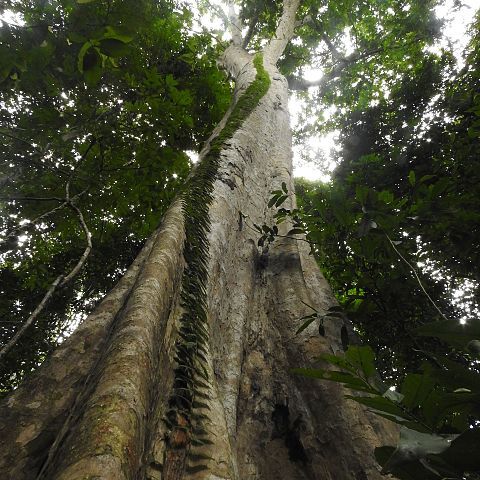Deciduous tree up to 43(-55) m high and 90 (-150) cm ø. Buttresses up to 5 m high, 2½ m wide, 15 cm thick. Bark greyish brown, not fissured, scaly, peels in irregularly patches. Leaves with 4-9 pairs of leaflets; rachis 6-25(-44) cm, petiole 3—16(—23) cm, both puberulous or pubescent, glabrescent, or glabrous. Leaflets chartaceous to subcoriaceous, elliptic-oblong, oblong, ovate-oblong to lanceolate, sometimes oblanceolate, 4½-20(-27) by 2¼-7(-10½) cm, usually glabrous on both surfaces; lower surface with hairy domatia, sometimes pubescent (or only on the midrib), glabrescent; base obliquely rounded, rarely sub-cordate; apex shortly acuminate, sometimes caudate; nerves 3-10 pairs; veins reticulate, some obliquely cross-bar-like; petiolules 0-⅓ cm, the terminal one ¼-1¾ cm, puberulous. Panicles up to 50 cm long, pubescent, glabrescent; branches up to 37½ cm long; floral bracts ovate, 1-1½ mm long, puberulous on both surfaces; pedicels ⅓-2 mm. Flowers white or greenish white. Calyx lobes ovate-oblong, 4-5 mm long, sparsely puberulous outside. Petals oblanceolate, sometimes elliptic-lanceolate, 7-10 by 1½-2 mm. Stamens 5½-7 mm; anthers oblong or ovoid-oblong, 1-1¼ mm long-Disk c. 2½ mm ø, puberulous. Pistil 5½-6½ mm long. Ovary oblong-ellipsoid or slightly obovoid, c. ⅔ (sometimes in young flowers c. ½) the length of the pistil, 1½-2 mm ø. Drupe globose, 1¾-2½(-3½) cm ø, larger when fresh; dingy brown when ripe, distinctly 5-celled; endocarp lentiform, 1-1¾ cm ø, often smooth, sometimes slightly irregularly 5-angular. Seed conical, ¾-l cm long.
More
A large tree up to 50 m tall and with an umbrella shaped crown of leaves. It often has buttresses at the base. The leaves are hairy and compound with both the leaflets and leaves carried alternately. The leaves come one after the other on opposite sides and have 5 to 7 pairs of leaflets. The leaves are pointed at the end and bluntly pointed at the base. The leaflets have a smooth edge. Young leaves are reddish colour. The flowers are small white, with no smell and carried as several on a stalk. The fruit are yellow and round. The fruit is 2-3 cm across and has 5 flecks around it. There is little edible flesh around a flattened seed.
Only in high-rainfall areas, although sometimes with a short dry season, in evergreen to slightly deciduous forest on well-drained to poorly drained soils, in levee forest, secondary forest, rather common but mostly scattered, at low altitude, rarely at 500-1000 m. Fl. fr. Jan.-Dec.According to CORNER Ways. Trees 1940 104 the leaves are in Malaya shed after dry weather, the trees having evidently two seasons, one about July-August, the other about December-January. The buds open before all the old leaves have fallen and inflorescences are produced at the base of the new shoots (in the axils of scale leaves) before the foliage.
More
A tropical plant. It grows in lowland rainforest and in valleys up to about 800 m. It occurs in high rainfall areas. It grows in areas with an annual rainfall between 1,800-2,900 mm. It is common throughout the Philippines at low altitudes. The tree also occurs in other SE Asian countries. They are common from northern Luzon to southern Mindanao in the Philippines.
Scattered on well drained to poorly drained clayey to stony soils, mainly alluvial flats and swampy areas in primary or secondary, evergreen or semi-deciduous (monsoon) forest from sea level to elevations of 500, occasionally 1,000 metres.
Uses. The timber is rather soft, rather light to moderately heavy, little durable. The sapwood is pale and subject to insect attack. The heartwood varies considerably from greyish brown, usually with dark grey to black bands, to almost black. Boles have a mean maximum branch-free height of 25 m, a mean maximum d.b.h. of 80-100 cm, but they are usually heavily buttressed. The timber is in demand for matched sliced veneers, but also suitable for rotary veneers; also suitable for panelling, furniture, quality cabinet work, flooring, boxes, matches. Trade names: sengkuang (Malaysia), paldao (Philippines), dar (West New Guinea), New Guinea Walnut (Papua New Guinea).A handsome and ornamental tree which could be used effectively for avenues.The fruit is inferior and sought mostly by children. Flowers and leaves may also be eaten as a vegetable ( CORNER Ways. Trees 1940 104 ). The bark is possibly of medicinal value (BURKILL).
More
The fleshy part of the fruit is eaten raw. It is sour. They are used as a sour relish. They are used to flavour curries. The fruit can be cooked with soy sauce and eaten with rice. The flowers and leaves can be cooked and eaten as a vegetable. The kernel inside the seed is edible. CAUTION The sap of the tree may be irritating and /or poisonous.


